Top News
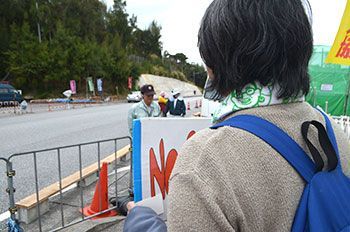
February 8, 2017 Ryukyu Shimpo
Yoko Tabuki
One woman in her 60s has been making her way from Naha to attend protests in front of the U.S military base Camp Schwab in Henoko, Nago. Her two daughters are married to former U.S. soldiers, one of which is currently employed as a civilian on one of the bases. The woman continues to participate in protests despite her family’s situation because of her mother, who had suffered through the Battle of Okinawa and suffered from it even after the war had ended. The woman is against the bases because she feels that they will lead to war. Her strong belief is clear in her words: “I will stop the construction of the base. I will not give up.”
The woman’s mother and grandmother frantically ran to escape the fires during the war. The woman’s grandmother later passed away from pneumonia. Traumatized by war, the woman’s mother was unable to tell anyone for 30 years that she did not shed a single tear even when her own mother had passed away. The woman said, “(Because of this,) my mother had suffered for the remainder of her life because she thought there was something wrong with herself.” It was war that had tortured her mother to the end of her days. Because of this, the woman’s resolve to never let war happen again eventually led to opposing the bases.
When her daughters were young, the woman would take them with her to participate in protests, like encircling the bases. However, her two daughters eventually married U.S. soldiers. The woman initially strongly opposed it, but ultimately allowed it since “individuals are not the same as organizations.”
However, the woman’s view changed after her grandchildren were born. “I don’t want any of my family members having to take part in war,” she said. Her two sons-in-laws accepted her wish and left the military. One currently works on the base in Okinawa as a civilian who transports materials.
Sometimes, her son-in-law who works on the base passes by in front of the gate when she is protesting. She shows him a forced smile when he later says, “You were there (protesting in front of the gate), weren’t you mother?” She told us with a cheerful smile, “The situation complicates things, but for my children and my grandchildren’s sake, I won’t let (them) construct the base. If our generation runs away from this, it would set a bad example for the younger people.”
(English translation by T&TC and Chelsea Ashimine)
Go to Japanese
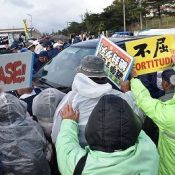
February 9, 2017 Ryukyu Shimpo
On the morning of February 9, about 250 citizens gathered at the three gates to Camp Schwab to protest construction of a new base in Henoko, which is meant to act as a replacement facility to Futenma Air Station. The number of riot police cars increased from four on February 8 to nine on February 9, raising tensions at the site as well. As of 10 a.m. that day no vehicles suspected to be transporting equipment or materials for construction were spotted entering the compound.
At 8 a.m., three vehicles suspected to be transporting workers entered Camp Schwab. Citizens attempted to stand blocking the vehicles’ path but about 20 riot police officers removed them to the side of the road, allowing the vehicles entrance onto the base.
Protesters chanted phrases in unison such as “Don’t bring workers in,” and “Stop ocean work.”
In Camp Schwab as of 10 a.m., the large crane ships used for placing concrete blocks underwater were moored with cranes contracted. Due to bad weather and high waves Okinawa Defense Bureau work ships were not seen on the water. It is unclear whether or not the multipurpose ship Poseidon 1 has begun its surveying work for underwater boring, although it has been seen moving about at times. Citizens opposing construction of the base in Henoko did not conduct protest activities on the ocean due to high waves and because it has not been confirmed that construction preparation is taking place.
(English translation by T&CT and Erin Jones)
Go to Japanese
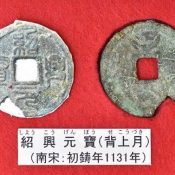
February 4, 2017 Ryukyu Shimpo
Two discoveries excavated from the Kyonouchi remains at Shuri Castle in 1996 had their origin determined this week. At the time of excavation, details regarding these artifacts were unclear, but it has been determined that the first discovery was Shokogenpo, the official currency from 12-13th century Chinese Nansong dynasty. The second was carved stoneware made sometime from the 15-17th century, which have images that were carved into the stone with small knives. The announcement was made on February 3 by the Okinawa Maizo Culture Center. The coins are the first of their kind to be excavated in Okinawa, and are specifically of the “Sekouzuki” variety, signified by the crescent moon pattern carved into the back side of the coin. The discovery of Sekouzuki coins are rare, and the culture center believes this to be the first instance anywhere in Japan.
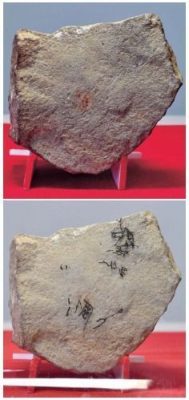
(Top) Carved stoneware unearthed at the Kyonouchi remains at Shuri Castle. (Bottom) After covering with a clear film, carved images of boats and tiny people can be seen. February 3, Maizo Culture Center
Shoujin Heshiki, head of the Okinawa Board of Education, commented, “These two discoveries are a rare and valuable thing.”
Shokogenpo coins were first minted in 1131 CE, and are generally an alloy forged with copper, and have a diameter of 3 cm.
The front surface of the roughly 15 cm square carved stoneware was used as whetstones to sharpen blades, and have the images of a sea voyage, with things such as sail boats and waves, carved into it. This is viewed to be a prayer for safe sea voyages.
Previously, stone slabs with sea-themed images carved into them have been excavated at Chatan and Kadena, but this is the first finding of a stone utensil with these depictions. The Maizo Culture Center is saying that it was likely carved by a mason or someone similar, but that the intent is still unclear.
Kyonouchi was a place used for prayer and rituals during the Ryukyu Dynastic era, and men were prohibited from entering. It is possible that the stoneware uncovered here were used
for a ritual, but the details remain unclear.
The artifacts will be on display in the,”Shuri Castle Kyonouchi Artifact Exhibit” at the Maizo Culture Center from February 21 through May 14. Entrance to the exhibit is free.
(Translated by T&CT and Sam Grieb)
Go to Japanese

February 8 2017 Ryukyu Shimpo
In Tomigusuku City, Nansei Sangyo which produced Ryujin Mabuyer, a local hero of Okinawa Prefecture, has joined with Seiginomikata Corporation which manages Tohokugoshin Miraiga, local heroes of the Tohoku area, to fund and set up an organization that will produce heroes in ASEAN countries. Based on the business model of the Ryujin Mabuyer, their new venture, ‘College Force’, aims to produce local heroes in 10 Asian countries in the coming 10 years.
Chairman of College Force Toshinari Hatanaka and the president of the company Narihiko Yoshida made this announcement at Okinawa Prefectural office on February 7. World Miraiga Project, an overseas venture by Seiginomikata Corporation, began airing TV show Miraiga T1 last November. Following the project, they intend to develop similar projects in other countries.
In tandem with Ryujin Mabuyer, they plan to distribute content featuring the existing local heroes in various parts of Japan.
Content production companies in Okinawa, Akita, and Tokyo, are co-founders of College Force, with 20 million yen in capital. Its headquarters is located in Tokyo, and it has a branch in Tomigusuku, Okinawa.
(English translation by T&CT)
Go to Japanese
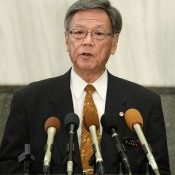
February 7, 2017 Ryukyu Shimpo
On the afternoon of February 7, Governor Takeshi Onaga strongly criticized the Okinawa Bureau of the Defense Ministry for dumping concrete blocks into the sea off Henoko, Nago despite his request to stop it.
The governor said, “I made a request that they (Okinawa Defense Bureau) not install [the concrete blocks into the sea]. I am filled with indignation because they took action like this without any advance consultation.”
He revealed that he would resend the document to the Okinawa Defense Bureau asking them to stop dumping the concrete blocks and provide a silt-curtain establishment plan.
Onaga said: “If the government forces through the construction work, Okinawan people’s growing emotion opposing it will turn into a protest against all U.S. military troops. I can easily imagine that it will become difficult to operate the military bases in Okinawa. Furthermore, it will lead to future trouble for Japan-U.S. Security Arrangements.”
(English translation by T&CT)
Go to Japanese
February 7, 2017 Ryukyu Shimpo
The government has started work in the ocean for the new Henoko base in preparation for large-scale land reclamation.
This outrageous behavior tramples on Okinawans’ overwhelming opposition to the construction, expressed in countless elections and opinion polls, and invites anger. Prior to the commencement of works, the prefectural government requested a detailed explanation of the work to be done, but the government unilaterally cut off discussions. We strongly protest the government’s high-handed disregard for local autonomy.
The new base will facilitate deployment of the dangerous Osprey aircraft and reinforce the U.S. base presence in Okinawa. It will also cause irreversible damage to the ocean, which is a treasure of the Okinawan people and a natural habitat that is also important from a global perspective. We reaffirm our demand that the government immediately cease construction, and call on the prefectural government to take all possible measures to prevent the construction.
Osprey’s defects become clear
The construction of a new base in Henoko will constitute an increase in the base burden borne by Okinawans and will entail massive destruction of nature. For these two significant reasons, it cannot be accepted.
The new Henoko facility will have both an airfield and a port for ships. Osprey and the new F35 fighter plane will be deployed and operated from the new base, leading to an indisputable increase in Okinawa’s burden.
The government long concealed the plan to deploy the defective Osprey, deceiving Okinawans.
An Osprey crashed at the end of last year, proving Okinawans’ anxieties about the aircraft to be well-founded. The accident that occurred during midair refueling drills bought to light defects in the aircraft’s body structure and training mode.
U.S. military documents reported on by the Ryukyu Shimpo acknowledged flaws in the Osprey’s body structure, indicating the possibility of midair refueling hoses and apparatuses bumping into the aircraft during refueling, and predicted the possibility of an accident, stating that a major tragedy could occur of the hose hit the Osprey’s propellers.
The recent accident happened just as described in the document. If the structural flaw in which the hose could into the propeller is not fundamentally resolved, another tragedy is inevitable.
The U.S. military and the government have made no comment on the reporting of these crucially important facts that show the impossibility of safe operation of the Osprey. And now, they are pushing forward with construction at sea. They are prioritizing the construction of a U.S. base at the sacrifice of Okinawan lives.
The sea area to be reclaimed is one of the last pristine ocean areas that remains in the vicinity of Okinawa Island.
In a survey of Oura Bay conducted by the Nature Conservation Society of Japan, more than 40% of the ocean floor was found to be covered by coral, which was assessed to be in healthy condition.
The 228 large concrete blocks to be dropped into the ocean will damage the coral and impact the endemic natural ecosystem. The International Union for Conservation of Nature has made multiple recommendations that the dugong be protected, but the Japanese government ignored them. The dugong disappeared from the area when floats were put up. The planned land reclamation will cause devastating damage to the natural environment in Oura Bay.
The abundant nature in the sea is also an important tourism resource. The lives of precious wildlife and one of Okinawans’ resources for tourism are about to be stolen away.
International solidarity and information strategies are needed
U.S. Defense Secretary Mattis visited Japan to meet with the prime minister and defense minister and confirmed support for the Henoko base construction. He showed no inclination to pay any heed to the objections of Okinawans or the Okinawa prefectural government.
The U.S.-Japan alliance is attempting to use force to suppress Okinawa’s popular will. But Okinawans will not give in. Okinawans will not resign themselves to being sacrificed by Japan and the United States.
The Okinawa prefectural government should not bend under heavy pressure from the U.S. and Japanese governments and should exercise all possible legal and administrative countermeasures.
The government plans to create as many fait accomplish as possible in quick succession, putting up a silt curtain after the blocks are sunk and then moving on to embankment work for the land reclamation. The government has also unilaterally asserted that procedures to renew the coral crushing permit, which will expire at the end of March, are “unnecessary”, and plans to forego the permit renewal and proceed with construction.
There will be no way to recover the nature that is lost through the land reclamation. The prefectural government should make no delay in taking such steps as revoking the previous governor’s approval of the land reclamation and taking legal action against unlawful crushing of coral.
Okinawans are facing oppression from the Japanese and U.S. governments, but they are not alone. We must spread opposition to the base construction in Japan and abroad and confront the two governments.
It is also necessary to counter the government’s manipulation of information with claims that local residents accept the construction and that the Osprey is safe. It is crucial to involve experts on military, legal and administrative matters, as well as environmental protection groups, and to advance information strategies to strengthen international solidarity.
(English translation by T&CT and Sandi Aritza)
Go to Japanese
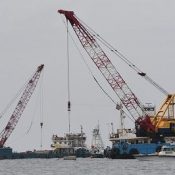
February 7, 2017 Ryukyu Shimpo
On February 7 at about 9:25 a.m., the Okinawa Defense Bureau (ODB) began work off the shore of Camp Schwab in Oura Bay, placing large concrete blocks underwater to form a temporarily restricted area for construction of a new base in Henoko, which is intended as a replacement facility to Futenma Air Station. Blocks were lifted and placed one at a time by large crane ship.
The ODB started the main part of work in the ocean on February 6. On this day, out of 228 concrete blocks that will be used as anchors for a silt-curtain, 2 large crane ships moved 28 blocks into place.
In the morning on February 7 the 4015-ton multipurpose ship Poseidon 1, which is surveying the area for underwater boring, was seen moving within the temporarily restricted area. At 9:30 a.m., it was not clear whether or not boring work had begun.
Meanwhile citizens opposing Henoko base construction gathered in front of Camp Schwab’s gate and raised their voices in protest against the placing of concrete blocks.
(English translation by T&CT and Erin Jones)
Go to Japanese
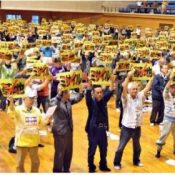
January 30, 2017 Ryukyu Shimpo
A public meeting against deployment of Japan Ground Self-Defense Force (JGSDF) to Ishigaki Island was held in Ishigaki City gymnastic hall on January 29, and approximately 800 people from around the city attended the meeting. The group adopted a resolution to oppose the city mayor Yoshitaka Nakayama’s announcement to accept the JGSDF. They concluded the protest while holding picket signs with the words “missile” and “base” crossed out.
Mayor Nakayama had said he would “to listen to opinions” from the four districts around the planned area before making any decisions on the deployment, yet the announcement of his approval was suddenly made public on December 26.
Opposing the announcement, the “residents’ liaison association to oppose militarization of Ishigaki” including the four districts held the public meeting. Ten residents from the four districts, war survivors and high school students spoke on stage.
Thirty-seven-year old representative of the four districts, Atsuko Nakatsuji, from Takeda district criticized the mayor, saying; “The mayor is going to allow the JGSDF to be stationed right next to schools where we send our children. There are residents and schools in our districts. It is really disappointing that we could not even have a talk.” She further demanded; “I hope our communities will be quiet and peaceful places where we can continue our farming.”
Seventy-nine-year old war survivor, Shigejiro Uehara who lives in Kawahara stressed the lessons from own experience.
“A place becomes a target of attack if there is a military base. We must not let them build a base.”
A senior student from Yaeyama Norin High School, Kokoro Nohara also shared her wishes.
“It is questionable how the government proceeds with the deployment plan without proper consideration. I hope the island will be a peaceful place to live in future.”
(English translation by T&CT and Sayaka Sakuma)
Go to Japanese
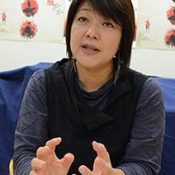
February 2, 2017 Ryukyu Shimpo
A new documentary film titled “Targeted Island Kaji kataka” captures the military base issue in Okinawa from residents’ perspectives. This is the third and the latest work of the director Chie Mikami following “The Targeted Village” and “We Shall Overcome (Ikusaba nu tudumi).” This film focused not only on Takae and Henoko, where the construction of the U.S. military base was forcibly carried out, but also on the livelihood of residents of Miyako Island and Ishigaki Island, which have been rocked by the deployment of the Self-Defense Forces (SDF). Focusing on the deep feelings of the people, who are the inheritors of island folk culture such as Angama and Pantu, the film aims to look at the base issue from a new angle.
“Kaji kataka” means “wind guard” or “bulwark” in Okinawan language. In the movie, there is a scene in which Mayor Susumu Inamine of Nago City says, “Once again, we were unable to be the kaji kataka that protects life.” He was speaking at the prefectural convention, which commemorated the victim of the murder case by the U.S. civilian military worker last summer. The film highlights an embedded structure in which Japan uses Okinawa as “bulwark,” and the U.S. uses Japan as “bulwark”. It depicts this theme as the background of the planned SDF deployment in these islands, the construction of the missile base, and the construction of the new U.S. military base on Okinawa Island. Stressing the lessons learned from the Battle of Okinawa – that the military base could become a target (of attack) and the army does not protect residents – the film warns of the danger of the current situation in Okinawa where militarization and fortification have become intensified.
Director Mikami said, “With the misunderstanding and brain-freeze of many, who think that the U.S. military and the SDF in Okinawa will be a deterrence, Japan is trying to provide land for the war which the United States and China do not need. It is my hope that the audience will understand that.”
In mainland Japan, there is a tendency to discredit activists in Okinawa by calling them “terrorists”, “professional citizens,” and “Chinese faction,” Mikami talked about the reason for including Okinawan folk culture in the film; “In reality, they are normal residents, and I wanted to convey each person’s thought.”
In Okinawa, a special preliminary screening will be held on February 16, 23, and March 2 at the Yoshimoto Minami no shima Panipani Cinema on Miyako Island. The film will be screened at Sakurazaka Theatre from March 11. On mainland Japan, the screening starts at the Porepore Higashinakano in Nakano, Tokyo, on March 25, and the film will be released in various places in succession.
For inquiries about Sakurazaka Theatre, call 098 (860) 9555. For the schedule of screenings in Japan, call ToFoo 03 (5919) 1542.
(English translation by T&CT and Megumi Chibana)
Go to Japanese
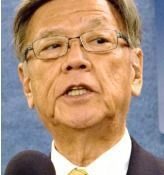
February 5, 2017 Ryukyu Shimpo
Sakae Toiyama reports from Washington D.C.
On February 3, Okinawa Governor Takeshi Onaga, who visited the United States to call for the cancellation of construction of a new U.S. base in Henoko, Nago, held a press conference in Washington D.C.
U.S. Defense Secretary James Mattis and Prime Minister Shinzo Abe reaffirmed their commitment to the relocation of the U.S. Futenma base to Henoko at their meeting held on February 3 in Tokyo. Regarding the meeting, the governor said, “If they adhere to the policy that Henoko is the only solution, it will lead to future trouble for Japan-U.S. Security Arrangements.” He added, “I will continually oppose the construction of the new base in Henoko. My determination is getting stronger.”
During his visit, the governor hit back at the governments of Japan and the U.S. after they confirmed they would push on with the Henoko relocation, saying, “It is very disrespectful to the Okinawa prefectural people.”
“A big political force against the Henoko relocation has been building up. The elections have demonstrated public opinion opposing the base construction. A tough approach to the people will incur damages [to security arrangements],” he said.
Nago Mayor Susumu Inamine, who visited Washington D.C. to lobby the U.S with the governor, criticized the meeting between the Prime Minister and the U.S. Defense Secretary, saying, “They say Henoko is the only solution without giving any reason. The prefectural people will absolutely not be convinced by this argument.”
“I will exercise power as mayor for citizens,” he said, vowing to block the relocation.
The governor emphasized the achievements of his visit:” We were able to gain understanding on the Okinawa base issues, including the construction of the new base, from members of the Senate and House.”
He said, “I will continuously call for a resolution of the new base issue through the human network that has been built, information gained through the discussions from this visit, and the Okinawa Prefectural Government’s Office in Washington D.C.”
(English translation by T&CT)
Go to Japanese
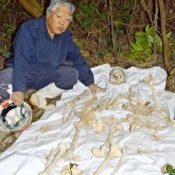
February 1, 2017 Yukiko Toyohama of Ryukyu Shimpo
On January 31, a complete skeleton believed to belong to a Japanese soldier from the Battle of Okinawa was found in a cave at Asato, Yaese. The remains are complete with a skull, shoulder blades, tailbone, thighbones, shin bones, upper arm bones, etc. Even teeth, specifically three teeth from the left and right sides of the bottom jaw, were found. Mitsuo Matsunaga, the 63-year-old chairman from the NPO Corporation Okinawa Limestone Cave Association in Yaese, has been voluntarily recovering remains for the past 30 years or so. He said, “It’s been 72 years since the war has ended, but the war still isn’t over. It’s rare to excavate a complete skeleton (preserved) so nicely, it’s practically a miracle. If possible, (we) would like to return (the remains) back to the family of the deceased.” He is calling out to people in hopes of gathering more information.
On August 25 and 26 of 1983, the Ryukyu Shimpo published a series of articles titled “Excavating the Ravages of War – Crossroads of Encounters.” Within the series was an article, “44th Independent Mixed Brigade Engineer Unit Headquarters,” which told the story of the unit headquarters previously located in Asato of former Gushichan Village. This article lead to the discovery of the remains. The article recounts the squad being annihilated by the U.S. military’s attack and that about 30 sets of remains had yet to be recovered.
A man from Naha in his 60s who used to visit a cave with his father as a boy to pay their respects had saved the article. Every year, he would visit on the Okinawa Memorial Day and had always wondered if the remains had been recovered or not.
The man then contacted the Okinawa Limestone Cave Association and together, they checked the cave on January 18. Human bones were found three meters below a 60-centimeter hole.
The volunteers, including Matsunaga, then recovered the remains. Items, such as a thermos, a lid from a lunch box, bullet(s), pieces of pottery, and button(s) with four holes were also found. However, none of which could be used to identify the remains. Matsunaga said, “We were able to recover remains based on a testimony. If there is anything more anyone can tell us, we hope that they would share it with us.”
Examiner Osamu Nakano of the Public Interest Incorporated Association Okinawa Memorial Peace Foundation for Fallen Soldiers’ Remains Recovery Information Center surveyed the cave. Judging from the shape of the cave, he believes that it is different from the one that was described in the article. Nonetheless, he said, “(We found) upper arm bones from both the left and right sides and it is a complete skeleton. Looking at the items that were also found at the scene, it is very likely that (the remains) belong to a soldier.” He also calls out to the public for more information. If you have any information, please contact the Okinawa Memorial Peace Foundation for Fallen Soldiers’ Remains Recovery Information Center at 098 (997) 4123.
(English translation by T&CT and Chelsea Ashimine)
Go to Japanese











 Webcam(Kokusai Street)
Webcam(Kokusai Street)


